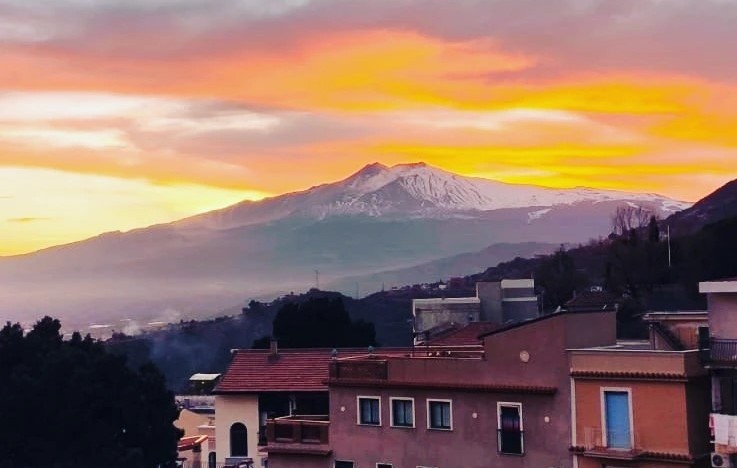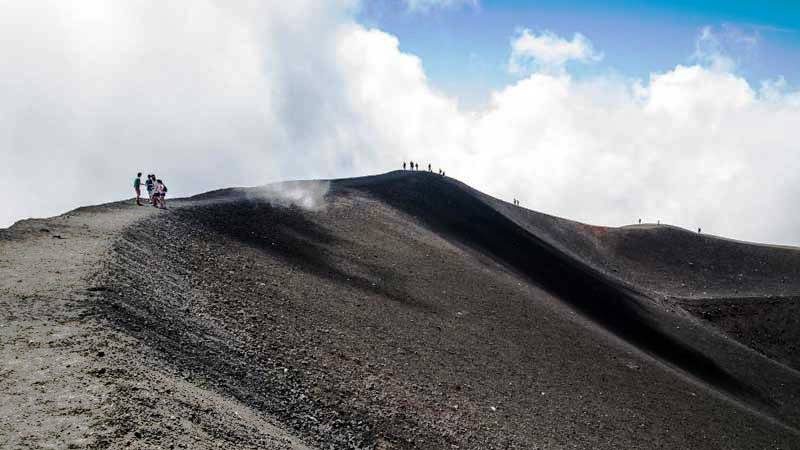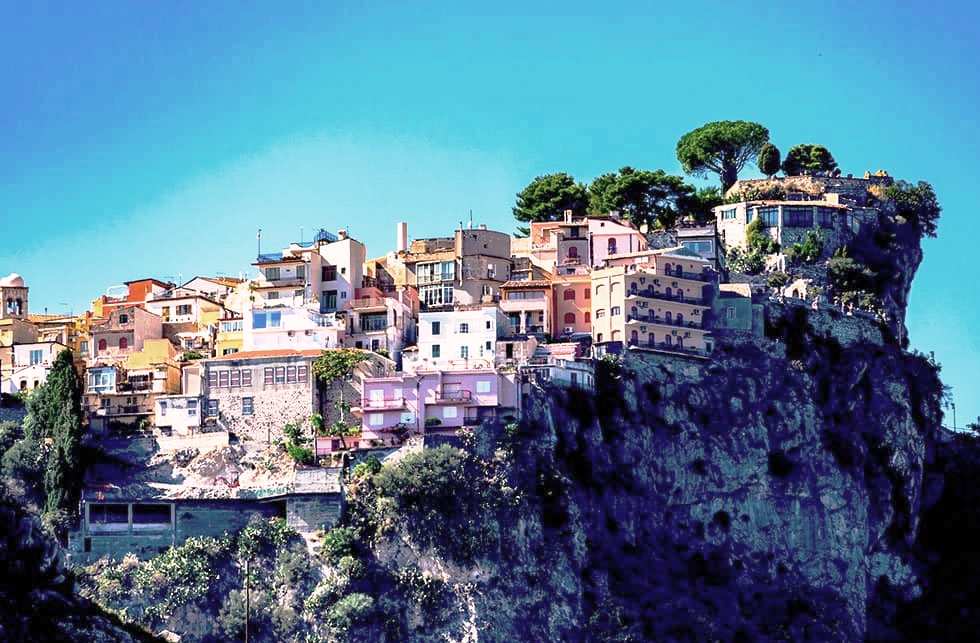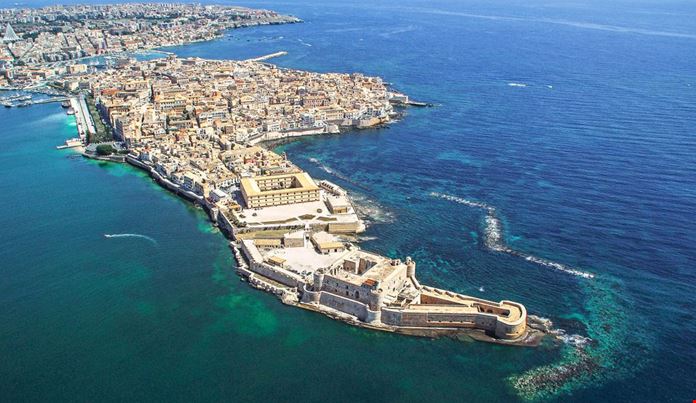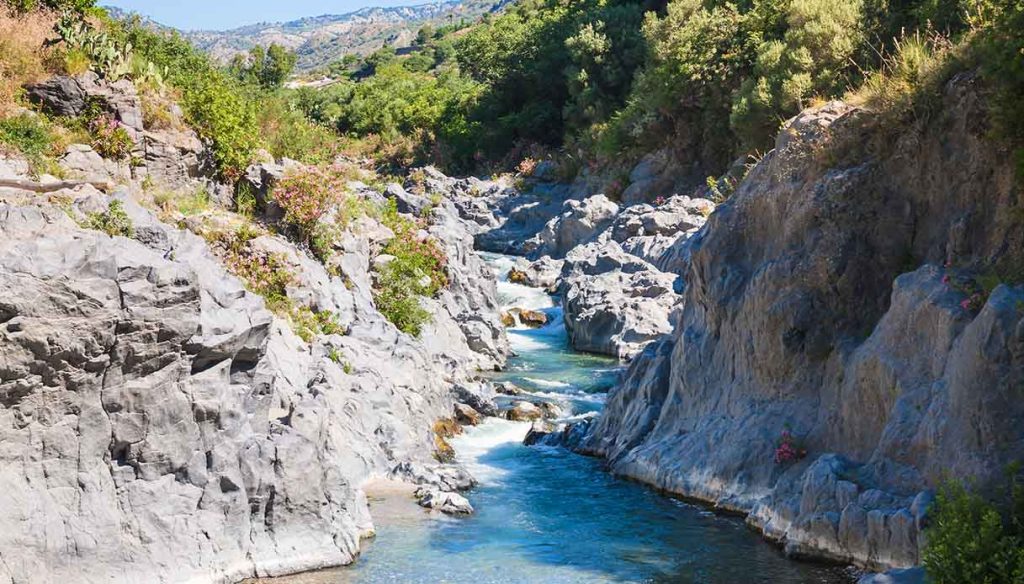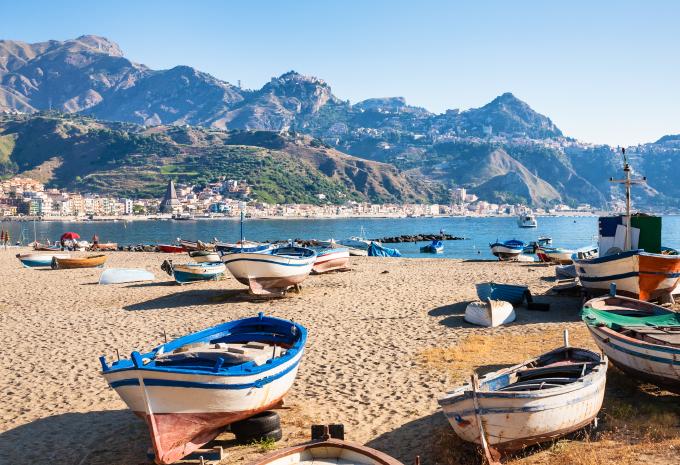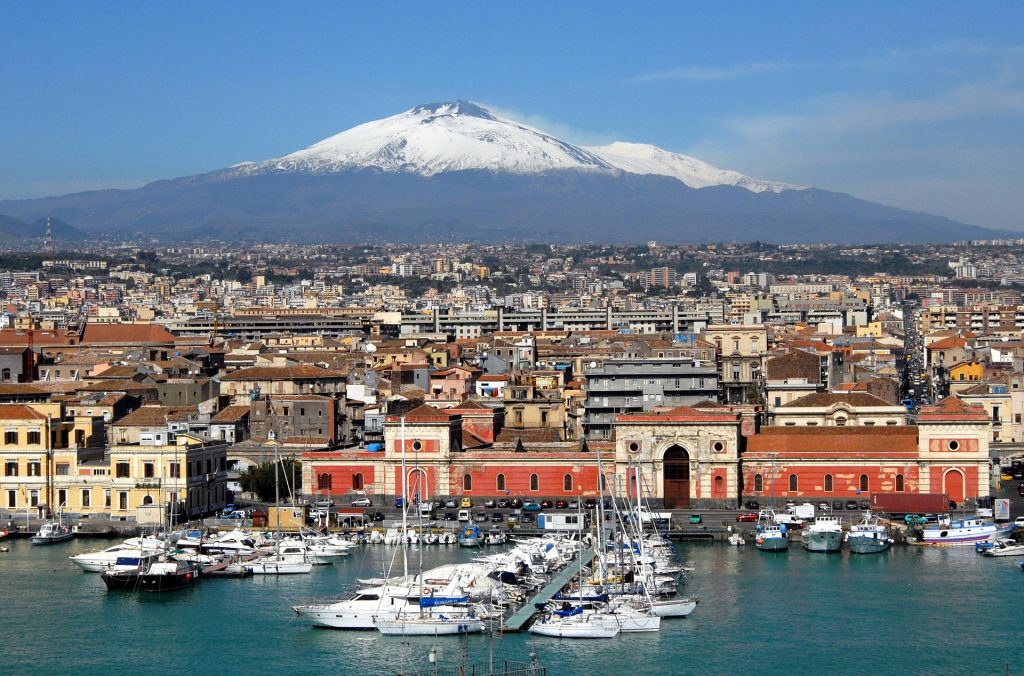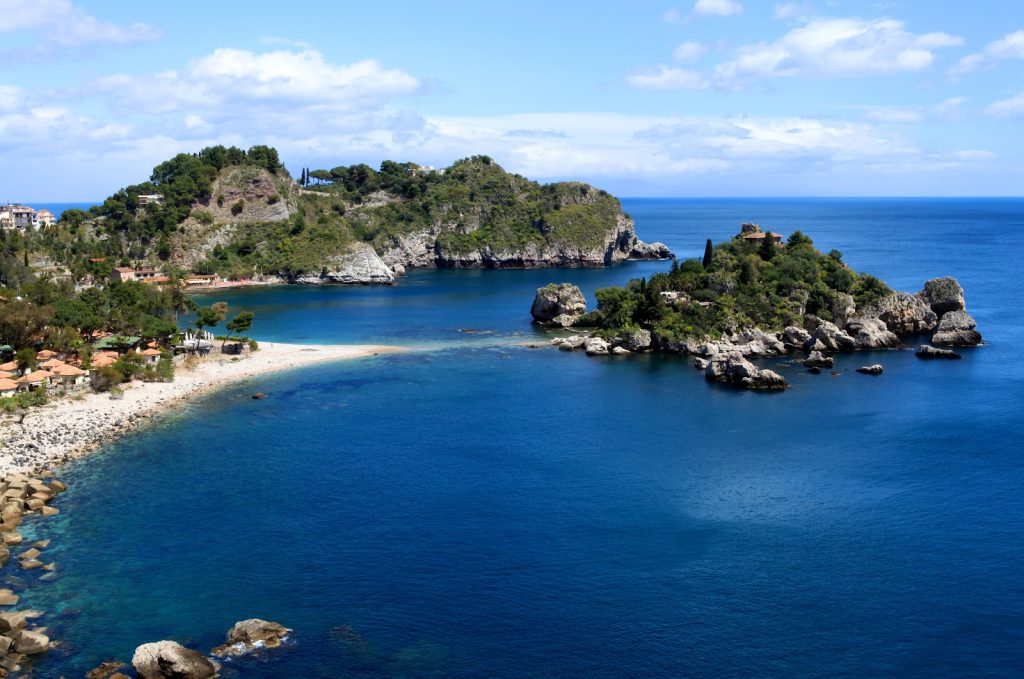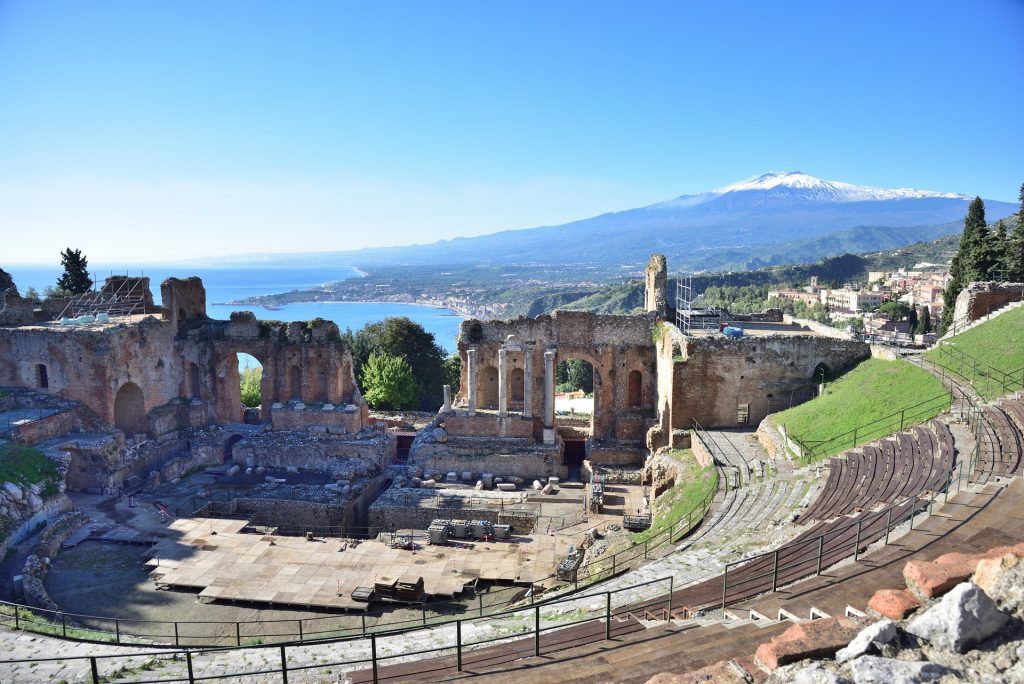TOP ATTRACTIONS
Taormina Sicily
ATTRACTIONS, ACTIVITIES AND TOURS
Mount Etna is the largest volcano in Europe with a summit of about 3,350 metres. It is widely known for its frequent eruptions; the most disastrous eruptions were those of 1669 and 1928. An observatory is located at the base of the central crater, at 2,942 metres. Vegetation follows the typical stratification patterns: a cultivated area up to 1,300-1,400 m, followed by a wooded area up to 2,000 m, with desert above that.
The excursion to Mount Etna is one of the main tourist attractions and is strongly recommended. The ascent to the volcano can begin from either the north or the south side. The two trails offer different views and features. The trail from Nicolosi to Rifugio Sapienza is more bleak, black and desert whilst the trail to Piano Provenzana is immersed in green. Each season has its own charm and interest: in the spring it is nice to see the blooms, the summer offers better weather, whilst the winter is attractive for those who enjoy cross-country skiing.
CASTELMOLA
In an elevated location, about 2.5 km (1.5 miles) from the centre of Taormina, stands Castelmola, a delightful village with just over a thousand residents. The origins of Castelmola date back to the pre-Hellenic period. The name is inspired by the shape of the large rock on which it stands, reminiscent of a wheel (in Italian, ‘Mola’). This was once the location of Taormina’s ancient citadel, perhaps due to its elevated position. Today, a well-preserved medieval castle stands on the spot.
The village is built on a medieval plan that has changed little over the centuries due to the sparse interest paid to the location until recent times. Today, Castelmola is a charming village that attracts many tourists. In the many quaint bars and restaurants, visitors can enjoy excellent Sicilian cuisine, fine local wine and the famous ‘Vino alla Mandorla’ (‘Almond Wine’), a local speciality offered gratis to all visitors. There are a number of ancient monuments, such as the remains of a Norman castle, the village church, the churches dedicated to St. George and St. Blaise, and the Saracen door along the city walls.
SIRACUSA | SYRACUSE
The great and noble past of Syracuse is still clearly visible today in this dynamic city, nestled in one of the most beautiful bays in the Mediterranean. The chaotic urban sprawl of the modern part hasn’t forced itself upon the cradle of Syracuse, Ortigia (the small island adjacent to the coast and the oldest urbanized part of the city): the charm of its Classical monuments and the splendour of its Baroque façades have not been affected.
Syracuse’s fame is closley linked with its Greek history: from a time when the Greeks commanded the seas and, undermining the Carthaginians and the Romans, became the first great empire of the West. Many relics from that era remain, such as the Galermi acquaduct and the famous Arethusa Fountain, a source of fresh water in the heart of Ortygia, linked to the myth of Arethusa and Alpheus and celebrated by many poets and writers. The ancient centre of the city can be found in the Syracuse Archeological Park where the Greek Theatre, the Ear of Dionysius and, close by, the altar of Hiero II, are located.
The city was once defended by a wall and was dominated by the Castello Eurialo, the only surviving example of an unconquered and intact Greek fortress. In order to build it – and other contemporaneous Greek temples – several quarries were excavated, the most famous of which is the Latomia dei Cappuccini. Here, soldiers taken prisoner during the war with Athens were imprisoned and left to starve to death. Syracuse also has some partially intact temples, the most famous of which is the Temple of Apollo, the oldest in Sicily and located in Ortygia, and the Temple of Zeus, which is the second oldest temple in the city.
The Cathedral of Syracuse is none other than the beautiful Athenaion, built by Gelo after the victory of Himera. Inside, the history of Western religion can be traced: the central nave was built from the naos (the cella of the Greek temple), while the perimeter of the aisles is marked by massive Doric columns from the ancient peristasis.
THE ALCANTARA GORGE
The Alcantara River received its name from the Arabs who crossed it by a stone bridge at Calatabiano, (al-Qantarah in Arabic means ‘the bridge’). The river flows from the Nebrodi Mountains and is fed by the Castiglione and Francavilla rivers and by a spring at the foot of Mount Etna, just above Randazzo. The gorges are up to 25 metres high and between 2 and 5 meters wide at different points. Contrary to popular belief, this natural canyon was not carved out by water over the course of thousands of years. The most likely hypothesis is linked to a seismic event, with a wobbling motion that literally split the hardened lava (from Etna) in two, allowing the river to creep inside. This is proven by the fact that the face of the walls is intact and jagged.
Close to the town of Francavilla di Sicilia, Fondaco Motta – in the territory of Motta Camastra – is the most impressive and famous of Alcantara’s gorges. It is over 6 km (3.5 miles) long, the first 3 km of which can be explored by foot. The uniqueness of this gorge lies in the structure of its walls, created by a flow of basaltic lava (silicon-poor but rich in iron, magnesium and calcium). The lava cooled slowly, creating pentagonal and hexagonal prismatic shapes that mirror its molecular structure.
GIARDINI NAXOS
Located halfway between Catania and Messina (about twenty minutes by car or train), Giardini Naxos is within an hour’s travelling distance Fontanarossa airport. Naxos, founded by Chalcis in 734 BC, was the first Greek colony in Sicily. Since the fifties Giardini, now known as Giardini Naxos, has made an extraordinary progression from a small fishing village to what is now one of Sicily’s main tourist attractions.
Things to see: just a short distance from the enchanting bay, Naxos offers visitors glimpses from its past, such as the seventeenth century Spanish defensive bastions, surprisingly in keeping with their surroundings notwithstanding their purely military purpose; the Archaeological Park and attached Archaeological Museum, which house a number of artefacts discovered during various excavation digs; and the Museum of Natural History.
CATANIA
Catania is about 50 km (30 miles) from Taormina and is easily reached by public transport or car. Dominated by Mount Etna, Catania has much to offer visitors, starting in the Baroque city centre with the Elephant Fountain, the symbol of Catania, the Amenano Fountain (nicknamed ‘acqua a lenzuolo’ by the locals), and the Chierici and Pardo palaces. In the same square, you will find the Palazzo Senatorio (town hall), the cathedral dedicated to St. Agatha (built in the eleventh century by Ruggero I and rebuilt after the earthquake of 1963), the Palazzo Vescovile and Porta Uzeda.
Worth visiting is Castello Ursino, built in the thirteenth century, the Massimo Bellini theatre, and Palazzo Biscari (the most beautiful public building in the city), which houses a museum of archaeology. Don’t miss a walk along Via Crociferi where, starting from the arch of San Benedetto, you will pass the abbeys of Badia Grande and Badia Piccola, the churches of St. Benedict and of St. Francis Borgia, and finally reach the Jesuit College. Along Via Vittorio Emanuele, you will find the Ancient Theatre, made from lava stone in Roman style but with Greek origin, and adjacent Odeon. Not far from this street, you will find the houses of Giovanni Verga and Vincenzo Bellini.
As well as the shops along Via Etna, you can see: Piazza Università, Palazzo Sangiuliano, the façade of the Collegiate Church, Palazzo San Demetrio, the Church of San Michele Arcangelo, Piazza Stesicoro built around the remains of a Roman amphitheatre and Villa Bellini, from where you can enjoy a beautiful view of the city. At the top end of Via Etna, with its entrance on Via Longo, you can enjoy the charming botanical gardens.
THINGS TO SEE IN TAORMINA
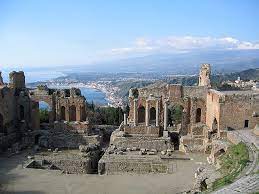
THE ANCIENT GREEK THEATRE
Built in the Hellenistic period, by carving into the hilltop, this is second largest classical theatre in Sicily (after that of Syracuse), with a diameter of 109 metres (the orchestra of 35 metres). It was enlarged and almost entirely rebuilt by the Romans and was restored in the 1980s. The structure takes advantage of the natural hill slopes. The arena was divided into nine wedges, each with 28 stepped tiers, and was crowned at the top with two porticos, one on the inside (of which traces still remain) and one, the most impressive, on the outside. In Roman times, the theatre ceased to be used for stage performances and was used instead for gladiatorial games. The original orchestra was transformed into an arena with elevated sides, necessary to keep the spectators safe from harm during such games. Typical of amphitheatres, a service corridor ran around the orchestra, the vault of which, now entirely collapsed, supported the base of the terraces. With the stage removed during the enlargement of the arena, the backdrop – the upper parts of which are still preserved – was merely for decorative purposes. The theatre then became a de facto amphitheatre. As in all amphitheatres, large open basins were located at the centre of the arena. Today, the acoustics are still remarkable. From the top of the seating, and even more so from the terraces that overlook the stage, there is a beautiful view of the backdrop with Mount Etna in the background, and, even further north, the Calabrian Mountains.
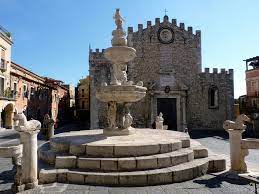
PIAZZA DUOMO
Further along Corso Umberto I, on the right side of the Piazza del Duomo you will find Casa La Floresta. In the courtyard of this ancient villa, fifteenth-century architectural features can be seen, such as the ogee-arched doorway on the ground floor and on the steps (very similar to those at Palazzo Corvaja), as well as sixteenth-century features, such as the two architraved windows on the first floor and in the contemporaneous semi-circular arched doorway. A staircase on the opposite side of the square descends into Piazzale San Domenico where the former convent of San Domenico is located. This building retains some of its original features, such as the southern cloister (sixteenth century) and the church’s bell tower (seventeenth-eighteenth centuries). The hotel retains some of its original monastic features mixed with Empire style furniture (second half of the nineteenth century). Below and behind San Domenico runs Via Roma, this street sweeps along the steep slope at the foot of the city and offers wonderful panoramic views throughout. At the end of the street you will find the public gardens or Villa Comunale, dedicated to the Duke Colonna di Cesarò. Here, you can enjoy beautiful views of Mount Etna and sweeping views along the coast as far as Acireale. Further along Via Bagnoli Croce you will arrive to Via Pirandello, near the Byzantine cemetery. Behind this, you will find the former San Maria di Gesù convent that retains its early sixteenth century cloister.

PALAZZO CORVAJA
Palazzo Corvaja is located in Piazza Vittorio Emanuele II. This palace was built in three successive stages (between the eleventh and the fifteenth centuries) and its original structure (the central part) dates back to the Arabic Age. The façade facing the square dates from the most recent fifteenth century restructuring. The upper floor mullioned windows rest, in typical Norman style, on a two-toned string course, on which is engraved certain moral judgements. The southwestern façade bears a three-light first floor window – stylistically consistent with the previous mullioned windows – and a heavily fortified archway that brings you into the courtyard. From here, a thirteenth-century exterior staircase leads you to a small arched doorway on a small landing with three reliefs (depicting stories from Genesis). To this side of the doorway, which leads into the first floor rooms, is a mullioned window. Today, this building houses the Sicilian Museum of Folk Arts and Traditions with displays of carts, puppets, folk costumes, ceramics, cribs, and other traditional artefacts from across the island.

PALAZZO DEL DUCA DI SANTO STEFANO
To reach the palace, turn off from Via Pietro Rizzo onto Via De Spuches that runs along the small garden attached to the Palazzo dei Duchi di Santo Stefano. The original structure of this building, which incorporated pre-existing walls of probable Arabic origin, can be traced back to the second half of the eighteenth century. A two-tone frieze runs along the north and east façades of this building, which also boasts two-light mullioned windows. The ground floor hall is accessed via a two-toned ogee-arched portal, framed with a strip of volcanic rock. The hall is covered with four vaults that meet at a column which stands in the middle of the room. Today, the restored building houses the Fondazione G. Mazzullo. Permanent exhibitions of sculpture and drawings by Giuseppe Mazzullo are housed throughout the three internal floors and in the garden; temporary exhibitions are also held.
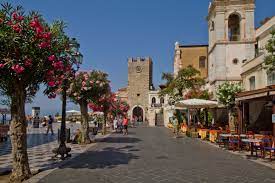
THE CLOCK TOWER
Built in the twelfth century on ancient Greco-Roman foundations, this tower has been destroyed several times by invading armies and each time rebuilt immediately afterwards. It was last renovated in 1679 due to the strong wishes of the people of Taormina; it was then that the large clock was installed. It is located in Piazza IX Aprile, in the middle of Corso Umberto, and marks the edge of the old town. The tower, which rises over Porta di Mezzo, is the gateway into the medieval village and separates the Classical and Hellenistic parts of Taormina. This stone structure is topped by battlements and bears a clock on its upper façade, while the gateway consists of an elegant arc of stone blocks. The tower was built in the late Middle Ages on pre-existing Hellenistic walls. Part of the original structure was damaged during essential restoration carried out in the second half of the eighteenth century. Recent studies suggest that the first tower was built on the ruins of ancient defensive walls, dating back to the origin of the city, around the fourth century BC. This view is supported by the fact that the tower’s foundations are made of large square blocks of Taormina stone.
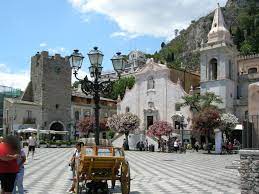
PIAZZA IX APRILE
This square cuts through the main thoroughfare of Taormina, thanks to its strategic location at the central point of Corso Umberto I. In fact, this area, running from Porta Catania to Porta Messina, can be considered the finest in all of Taormina. From the square’s vantage point, you can admire splendid panoramic views that sweep across the impressive Mount Etna, Bay of Giardini Naxos and the ruins of Taormina’s ancient theatre. The open-air bars and the portrait and landscape artists are common throughout this area. At the side of the square stands the former Gothic Church of Sant’Agostino, whilst the seventeenth-century Church of San Giuseppe dominates the square from the top of the steps. From here, the oldest part of the city can be reached through the Porta di Mezzo, over which stands the Clock Tower. The square is so called because on April 9, 1860, during mass in the Cathedral of Taormina, word spread that Garibaldi had landed at Marsala to liberate Sicily from the Bourbons. The news turned out to be false: it would be a month later, in fact, before Garibaldi landed at Marsala; nonetheless, the people wanted to remember that day and so dedicated the city’s most beautiful square to that date. Before then, the square was called Piazza Sant’Agostino after the church which was built in 1448. The former church still stands facing the square but today houses the public library.

THE CATHEDRAL OF SAN NICOLA
The Duomo-Cathedral of San Nicola was built in the thirteenth century on the remains of a previous religious structure; it was rebuilt in the fifteenth and sixteenth centuries and remodelled again in the eighteenth century. Its façade boasts a Mannerist portal from 1633 with richly decorated imposts and architraves, two fifteenth-century ogee-arched lancet windows and, above these, a small rose window with a central cross, from the sixteenth century. On the left side wall is a portal framed in pumice lava from the second half of the fifteenth century. This doorway is decorated with spiralling floral motifs on the imposts, the ogee-arch and along its architrave and has, at its centre, a depiction of Christ blessing Saints Peter and Paul. On the right side wall is another portal from the first half of the sixteenth century, with architraves and an ogee-arched fanlight. In front of the church is a fountain dating from 1635. The interior of the basilica has a nave and two aisles separated by an arcade of six columns. The first altar on the right is dedicated to the Visitation of the Virgin Mary with Saints Joseph and Zechariah, painted – with signature and date – by Antonino Giuffré in 1463. Over the second altar sits a polyptych by Antonello de Saliba (1504), the first panel depicts the Madonna and Child with Saints Jerome and Sebastian, the second panel depicts the Pietà with Saints Lucy and Agatha, and the predella depicts images of Jesus and the Apostles. On the altar is a gigantic alabaster statue of the Virgin and Child (from the first half of the sixteenth century) and to the left is a Mannerist tabernacle from 1648. To the right of the main altar, sits a chair emblazoned with the city’s coat of arms and flanked by two lions. The chapel to the left of the main altar, dedicated to the Blessed Sacrament, dates from 1749. On the second altar to the left stands a statue of St. Agatha, by Martino Montanini (sixteenth century). The first altar has depictions of the Enthroned Virgin and Child, John the Baptist and St. James and the lunette depicts the Eternal Father and the Crucifixion, painted on wood by Alfonso Franco (sixteenth century).
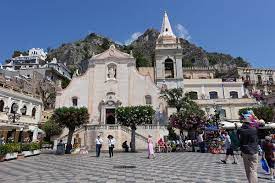
THE CHURCH OF SAN GIUSEPPE
This church, dedicated to St. Joseph, was built in the seventeenth century. It is located next to the Clock Tower and faces out onto Piazza IX Aprile. It was built in the Baroque style between the late 1600s and the early 1700s. A double staircase, with a balustrade of Syracuse stone, leads up to the entrance. The façade boasts a large central portal built from multicoloured Taormina marble. This leads inside where two further small side doors made from Syracuse stone lead to the sacristy (on the right) and to a small room often used for art exhibitions (on the left). On the right side of the church stands the great bell tower, the lower part of which is made from large blocks of Taormina stone. The church was the seat of the “Brotherhood of the souls in Purgatory” for which reason depictions of humans in flames – symbolizing purification from sins – can be seen at different places throughout the church and on its façade. On the central dome, above where the single nave crosses with the transept, you can admire a fresco that depicts St. John Bosco as a child standing between the Virgin Mary and Jesus. The Salesian Fathers have been present in this church since 1919.
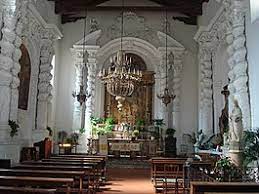
CHURCH OF SANTA CATERINA DI ALESSANDRIA
Dedicated to Saint Catherine of Alexandria, this church is located near Palazzo Corvaja and stands on the ruins of the ancient Odeon, which itself was built on the ruins of a Greek temple, most probably dedicated to Aphrodite. The church was built in Baroque style in the first half of the seventeenth century. Entering from the right, enclosed in a niche on a column, there is the marble statue of St. Catherine dating back to 1493. This statue was previously located in the ancient Church dedicated to St. Catherine located outside the old town walls, presently the Capuchin Church. The interior of the church has a single nave and an underground crypt, discovered during restoration that took place in the ’70s. Restoration also brought to light, in the right side of the church, the ruins of Greco-Roman walls and cobblestones, which had been enclosed by wrought iron railing. The portal is made from pink Taormina marble and all the external windows from Syracuse stone. A statue of St. Catherine, carved in 1705 by Paolo Greco, sits in a niche above the entrance on the front façade. The Church of Santa Caterina di Alessandria lay closed and in a precarious state for about 40 years until its restoration and public reopening on November 25, 1977.

THE ODEON
Behind the Church of Santa Caterina d’Alessandria d’Egitto and next to Palazzo Corvaja stand the remains of the Odeon, built during the Roman Empire and rediscovered in 1893. The Odeon mirrors the architecture of the larger Ancient Theatre, although, with a maximum capacity for 200 people, it is considerably smaller. The two theatres also face in different directions: the Greco-Roman theatre faces south whilst the Odeon faces north-east. The theatre has five seating wedges, mostly made from brickwork (i.e. with large clay bricks mortared with lime). The lower seating was accessed via a covered walkway that led to the centre whilst the upper seating was accessed via passageways which led to the long corridors that encircled the entire building. Today, the walls that supported the wooden stage still stand as does the remains of a room for the actors at the side of the stage. The backdrop for the stage incorporated the side wall of an earlier Hellenistic Doric temple (further remains of which can be seen beneath the floor of the Church of Santa Caterina). It is thought that the small Odeon, built in the centre of the ancient Greek city, was used for plays and musical performances and reserved for magistrates, elders, distinguished guests, soldiers and religious officials, as well as for their families.
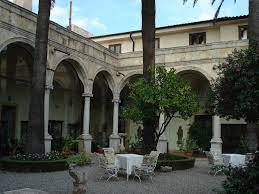
THE SAN DOMENICO
The San Domenico Palace Hotel, formerly a Dominican Convent, is today one of the most famous hotels in Italy. It was the first palace-castle (construction began in 1374 and was completed in 1383) and the third monastery to be built in Taormina. Its origin and history are tied to Damiano Rosso, a Dominican friar who was a descendant of the Altavilla family and Prince of Cerami.After becoming a friar he donated all his possessions – including the palace, which was converted into a convent – to the Dominican religious order. After many centuries, the building passed to the City of Taormina, which then sold it back to the princes of Cerami, who, in the early twentieth century, turned it into a hotel. The 40 friars’ cells are now elegant bedrooms. The only part of the old convent to remain open for worship was the chapel (dedicated to St. Agatha); however, this was destroyed by bombings on July 9, 1943. In fact, the hotel’s conference hall was built on the ruins of the chapel and the remains of the original minor altars can still be seen today. The former convent is accessed through a grand seventeenth-century doorway, above which the Dominican coat of arms is carved in marble. The square cloister – with seven arches on each side resting on 29 columns – is located just past the hotel’s lobby. There is also a second smaller cloister, with six arches on each side resting on 25 columns.
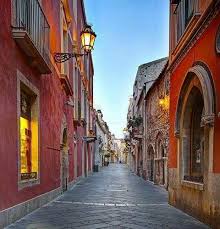
CORSO UMBERTO I
La strada, il cui tracciato ripete quello dell’antica Consolare Valeria, fu asse di sviluppo del primo insediamento greco-romano, colmato negli spazi This street follows the route of the ancient Consolare Valeria, the main thoroughfare in the original Greco-Roman settlement; the street is lined with buildings from throughout the ages, many being built upon older pre-existing structures. It begins at Porta Messina, rebuilt in 1808 (just outside the small sixteenth-century Church of San Pancrazio, built on the ruins of a Hellenistic temple dedicated to Jupiter Serapis), and ends at Porta Catania or Porta del Tocco, built in 1440 and marking the western edge of the old town.
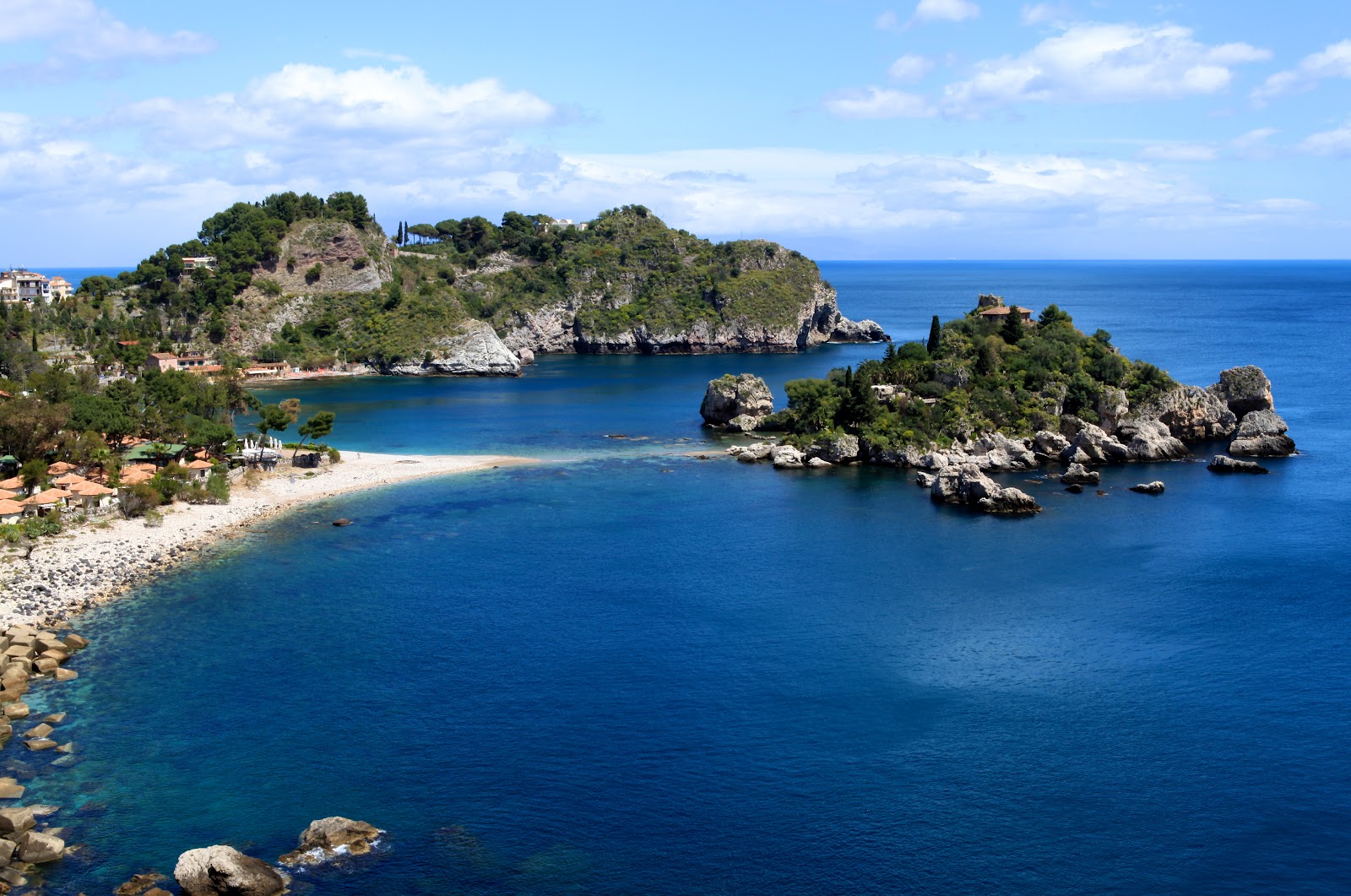
ISOLA BELLA &
BEACHES
Between rocks and gorges, the beautiful ancient soft beaches of Taormina emerge from the blue sea. They can be easily reached by foot, bus or cable car. Of particular note is Isola Bella beach, which stretches along the beautiful bay from Capo Sant’Andrea to Capo Taormina, now a nature reserve with the Regional Naturalistic Museum of Isolabella. Further north, the Mazzaro, Spisone and Letojanni beaches are located. On the south side, you will find the beaches of Villagonia and Giardini Naxos stretching as far as the mouth of the Alcantara River.
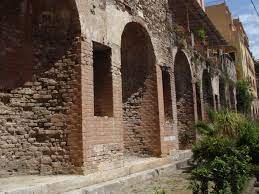
THE NAUMACHIE
The Romans, as well as modernizing the city, equipped it with the facilities necessary for economic development. Among these was the construction of a system for collecting spring water in large tanks. The so-called Naumachie are testimony to this commitment: these mighty 122 metre-long walls served as a supporting wall for a large reservoir of water from which hydraulic pipes irrigated the land across the valley. Among the buildings which incorporate Roman structures is the Church of Santa Maria del Piliere, now used as a shop, and on which can be seen an architraved portal with lancet arch (early sixteenth century). Further along Corso Umberto I, you will find the former Church of Sant’Agostino (1486) and further again on the right, at the top of a flight of steps, the Palazzo Ciampoli (1412) – now a hotel – in Gothic-Catalan style with a floor of narrow two-light mullioned windows.
Your booking directly from our official site!
Best available rate is guaranteed – Easy and safe reservations – Tailor made and exclusive offers
Directions
Hotel Continental Taormina
Via Dionisio I, nr. 2/A | 98039 Taormina ME | Telefono +39 0942 23805 | e-mail info@continentaltaormina.com
Codice CIR 19083097A300968
Codice CIN IT083097A1RNRKR3ZM
© 2025 · Hotel Continental Taormina Sicily

